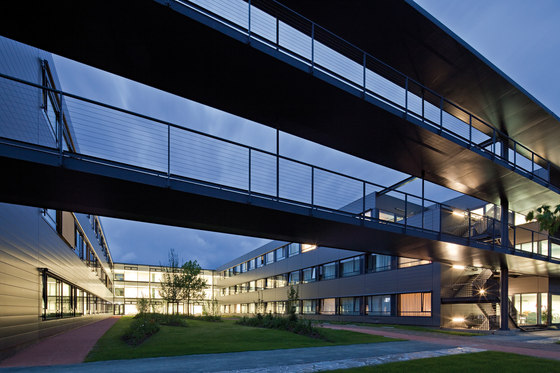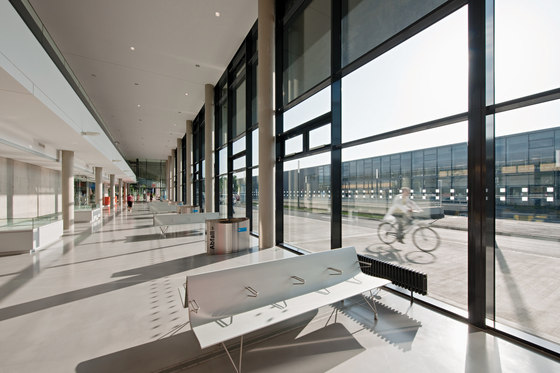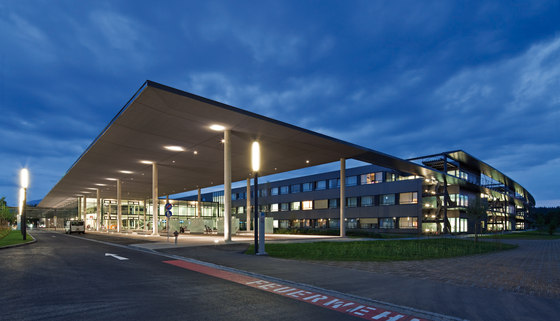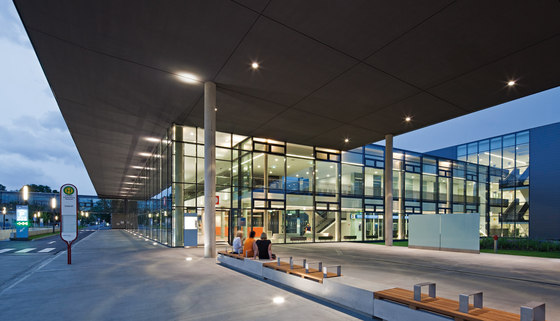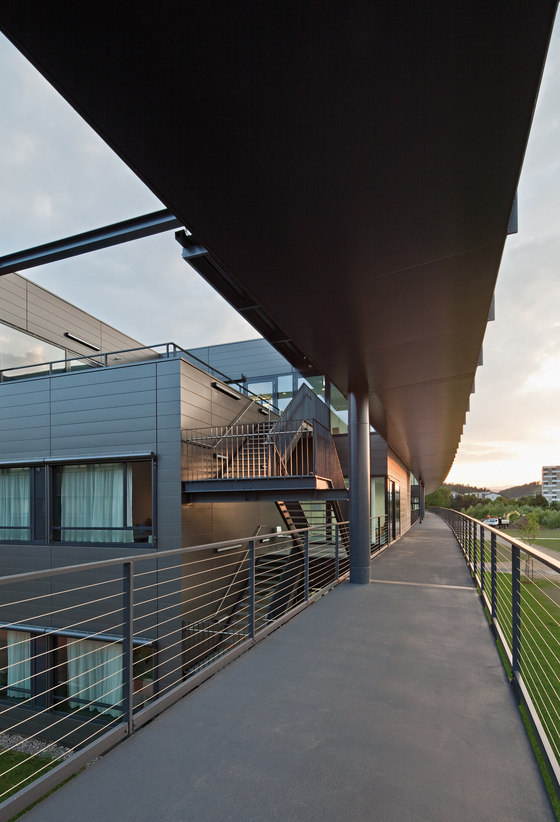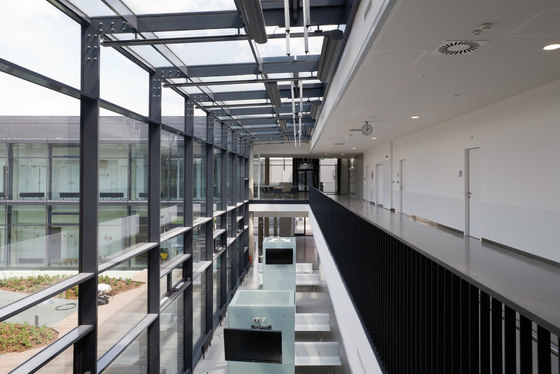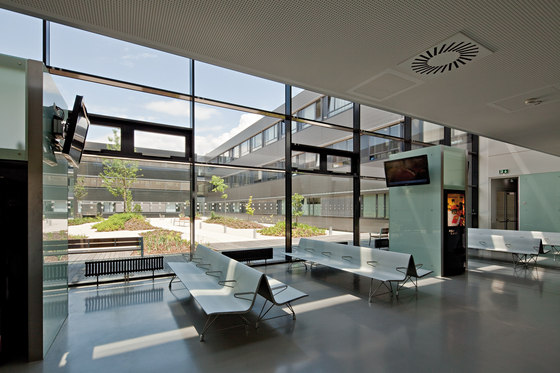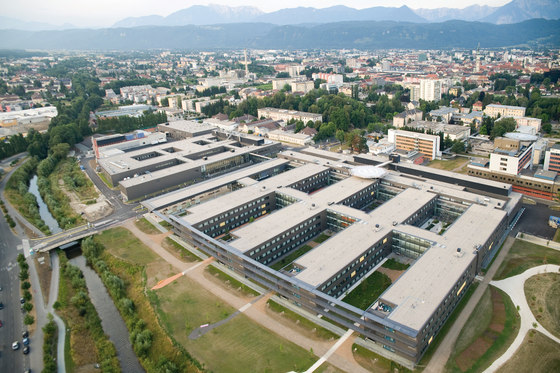A modern, innovative and trend-setting hospital
The new project for the Provincial Hospital in Klagenfurt is innovative in many ways. The latest Medical Technology along with an enhanced cross-utilization of medical equipment and facilities (operating rooms, examination and treatment rooms and wards in the logistics field) give this new hospital a pioneering status in Europe. Even before completion, it served as an example to future developments. The architectural concept is an important part of this modern definition of a hospital. The flat, two-storey building fits well into the landscape on a site where the wetlands of the Glan River close off the land to the north. The footprint of the building is largely determined by landscaped courtyards which open the building up to the site as well as carefully form more private areas for its users. The horizontality of the building is reinforced by the two main access routes: the curved corridor to the north, and the straight corridor which accesses the examination and treatment areas. Large multi-storey glass facades give these zones, which are designated as the waiting and circulation areas, an inviting and more transparent open character.
As a refreshing and straight-forward design proposal, the design for LKH Klagenfurt was chosen as the winner out of a two-stage design competition. The flat, low-lying structure merges easily with the low and heterogeneous urban surroundings of Klagenfurt. At the north side of the complex lays the floodplain of the river Glan. This scenic green space provides a filter between the urban space of the city and the hospital grounds. The horizontal division of the façade and the tiered structure of the form combine to further integrate the complex into the landscape. The comb-like organization of the buildings provides a strong visual relationship to the surrounding green areas for both the accommodation and medical wards. Thus the hospital rooms, access halls and waiting areas all become sun-drenched and comfortable health-stimulating light therapy rooms. This tangible connection to the natural surrounds is an integral part of the new Hospital Klagenfurt.
Relation to the landscape
The direct link between the patients and staff to the lush riverside and planted courtyards is an integral part of the architectural concept. Each garden courtyard between the different programs of the hospital is differentiated by the specific design and color of its diverse vegetation. This means that these green spaces can also be used as references for orientation within the complex. The ground cover and vegetation is given ample soil and space to grow and mature in the coming years as the landscape becomes increasingly more natural.
A uniform structure
Upon arrival, a generously sized canopy greets visitors and steers them towards the two-story entrance hall. The open, glazed eastern facade of the main hospital building is mirrored by the glass facade of the cafeteria in the supply center to the west. A light, enclosed pedestrian bridge suspended from the main buildings connects these two units. Bus stops are located on either side of the road, along with the main entrance to the parking garage. Emergency vehicles have their own designated lane which branches off to the west and leads to the emergency room. An open visitor parking area and a second entrance to the garage are located to the west of the building. The design creates a functionally coherent organizational structure with simple routing and good guidance from the two key circulation areas: the straight outpatient treatment corridor and the main visitor path to the north. Spacious glass facades give these corridors and the waiting areas an open, welcoming character through the use of bright, fresh colors. The supply and disposal logistics center is located along the main access route towards the east. The center builds upon the set U-shaped modular building structure established by the rest of the complex. A chapel and prayer room are located in the northern section of the complex. This area is distinguished by its materiality (wood) and design style. The altar is hung from the ceiling and placed nearby a large-format glass image from the local artist Karl Brandstätter.
Wellness
The bright, naturally lit rooms have been designed to create an intimate relationship with the courtyards in order to provide a comfortable hotel atmosphere. The dark gray metal skin of the building provides the background for the busy planting of courtyards, and gives the building an identity which does not automatically induce the feeling of a hospital. The grey metallic color of the exterior cladding lends an industrial character to the building. The color and finish of the material plays with the daylight to make the courtyards brighter or darker according to the time of day. The dark color of the skin also has a positive effect on the thermal performance of the building. The alternation of glazed and clad sections of the façade introduces a rhythm along the surface of the exterior. The yellow window awnings in their extended state work to further animate the façade. The horizontality of these aspects of the design serves to further elongate the building and avoid monumentality.
Organization of the Surgical-Medical Center (CMZ)
The primary circulation of the building is from the north-east corner to the entrance hall in the center of the hospital grounds. The main entrances are all easily reached by bike or public transit from the city center. Western access to the CMZ is also connected to the parking garage and the open visitor’s car park. To take advantage of natural lighting, the programmed spaces are east-west oriented. The specialty medical and outpatient departments are organized along the central patient corridor which forms the structural and functional spine of the facility. The wards and medical units are accessed via the two main east-west corridors and through the entrance hall. North-south corridors run along the courtyards and connect the wards with the central clinic building to the south. Each ward is equipped with a compact unit of two nursing stations which are centrally located with easy access to the supply/disposal system. All hospital rooms and lounges are oriented towards the courtyards to take advantage of natural light. The intensive care wards are located in the immediate vicinity of the operating area located on the first floor. These wards are connected to the operating rooms by internal corridors at the nursing stations. Waiting areas for patients and visitors are placed along the large northern corridor. The surgical center is located on the first floor of the south wing, with the administrative area directly above. The center is directly connected to the emergency room on the ground floor, and the helicopter landing pad above. The parking garage runs on the first basement level under the outpatient clinic center, and extends east to the logistics center. The new media collector system runs along the road at this first basement level from the energy center of the VEZ to the center of the CMZ. Parallel to this system runs the underground tunnel system which is facilitates the disposal of waste and the delivery of supplies. All of these areas will be operated by using an automated guided vehicle system (AGV). The outpatient centers at the south wing and the specialty medical departments are all directly connected to nursing stations. The medical departments on the ground floor, surgery departments on the first floor, and nursing stations on the ground, first and second floors can all be accessed via the two main east-west corridors and through the main entrance hall. The curved southern corridor accesses the wards and serves as a communication axis for the patient. This simple spatial arrangement of departments and access is achieved through the utilization of spacious garden courtyards.
Supply and waste disposal center (VEZ)
The VEZ is responsible for supplying all of the energy, heat, steam, logistics, pharmaceuticals, sterile goods, and dining and laundry supplies to LKH Klagenfurt. In addition to this, the VEZ is also the central repository for waste disposal. Like the CMZ, the VEZ is located between two large corridors, and contains inner courtyards.Though it functions at the scale and scope of an industrial building, special consideration was given to maintain the same living and working conditions awarded to the patients and staff of the CMZ. The courtyards create large areas of green space which serve as outdoor spaces for staff while on break, and provide a garden view for the cafeteria.
Organization of supply and waste disposal center
This 2-storey building, together with the solitary structures of the laundry and waste collection centers, and the formerly-existing buildings, forms a large farm yard which encompasses all supply and waste disposal activities in the hospital complex. Since the entrance to this facility branches off before the main entrance to the hospital, the entire hospital area is able to remain free of truck traffic, thereby further contributing to the quality of the stay of the patient. The 2-storey, windowless façade of the energy center stretches along the main access road as a contradiction to the transparent, glass façade of the dining room. A light, cantilevered bridge connects the units of the CMZ with the VEZ, and signals the main entrance of the Klagenfurt hospital.The main lobby on the ground floor comprises the central area of food distribution. The open-concept design allows for an employee-dining area as well as a visitor cafeteria. The visual relationship to the main entrance and the connection to the garden in the courtyard of the VEZ give this space a special atmosphere and offer employees the best possible relaxation and recreation during their lunch breaks. The upper floor is accessed via a gallery which houses an event and conference center. The central warehouse and workshops extend west towards the courtyard, and are supplied via ramps from the loading area of the VEZ. These, seemingly more minor programs are also configured around garden patios so that they offer well lit and pleasant working conditions for staff. The post office, telephone and security control center are also housed in this component.The central kitchen is adjacent to this area; separated by the north corridor, and the central warehouse, and by the main structure of the VEZ in the north-west. It begins at basement level two, and extends to the ground floor. By terracing the adjoining courtyard, each basement level is naturally lit, and given unobstructed views to the garden outside. The laundry, like the waste collection center, is situated as a solitary building component. In addition to LKH Klagenfurt, it also services the hospital in Villach, Wolfsberg. The automated guided vehicle system (AGV) encrypts and disposes of waste from the new development areas of the Hospital of Klagenfurt and from all of the other existing buildings at LKH Klagenfurt. This occurs via a 2 km long, underground tunnel system. This underground tunnel system connects to all lifts in the new building and existing buildings. This system allows for the delivery of each container of goods to their respective storage areas without risking any possible interaction with patients or visitors.
EU Green Building Certificate
Established in 2005 the "Green Building" certification by the European Commission aims at improving the energy efficiency of buildings in the EU. In order to be certified the building must demonstrate an energy savings (heating and cooling) of more than 25% below the minimum values of the OIB (Austrian Institute for Building Technology) Directive 6. The OIB is the Austrian implementation of the EPBD directive (Energy Performance of Buildings Directive) of the EU for the overall energy efficiency of buildings. 500 "Green Buildings" within the EU have been certified so far, among them 30 in Austria by the national partners of ÖGNB (Austrian Society for Sustainable Building). The certification of the CMZ (SurgicalMedical Center) of the Hospital of Klagenfurt was filed by the owner, the KABEG (Carinthian Hospital Association) in September 2011 and the building became the first hospital of this size in Austria to receive it. The building is distinguished by its compact building structure, very good thermal insulation of the outer shell and optimized building technology systems with heat recovery. the low cooling demand was controlled centrally and reached movable external shading and energy-saving lighting systems. the heating requirement of the building is 36 percent and the cooling demand 41 percent below the required values of the OIB guidelines.
Gross floor area: 145.000 m²
Prizes and Awards
Carinthian Architecture Awards 2010
Nominated for the EU Mies van der Rohe Award 2011
Austrian Clients Awarads 2011
LKH Klagenfurt
Müller & Klinger / Architects Collective AC ZT-GmbH
DFA Dietmar Feichtinger Architects
Priebernig. „P“ ZT GmbH Architekten + Ingenieure
Project manager: Dietmar Feichtinger, Heinz Priebernig, Richard Klinger, Walter Nemeth
HVAC consultant: ZFG Projekt GmbH
Structural consultant: FCP Fritsch, Chiari & Partner ZT-GmbH; Ertl, Horn & Partner ZT-GmbH
Electrical consultant: TB Hartl & Co KG EPG Elektroplanung GmbH
Landscape: Idealice
